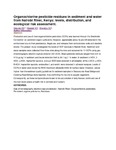Organochlorine pesticide residues in sediment and water from Nairobi River, Kenya: levels, distribution, and ecological risk assessment
Abstract
Production and use of most organochlorine pesticides (OCPs) was banned through the Stockholm
Convention on persistent organic pollutants. However, appreciable amounts are still detected in the
environment due to their persistence, illegal use, and releases from contaminated soils and obsolete
stocks. The present study investigated the levels of OCP residues in Nairobi River. Sediment and
water samples were collected from three sites along the river and screened for 17 OCPs using gas
chromatography electron capture detector (GC-ECD). Mean pesticide residues ranged from 0.01 to
41.9 μg kg-1 in sediment and below detection limit to 39.7 ng L-1 in water. In sediment α-HCH, β-
HCH, γ-HCH, heptachlor epoxide, and p,p'-DDD were detected in all samples, while α-HCH, γ-HCH,
δ-HCH, heptachlor epoxide, endosulfan I, and endrin were detected in all water samples. Levels of
OCPs in water were below the WHO maximum allowable limits for surface water. However, values
higher than the sediment quality guidelines for sediment samples in Racecourse Road Bridge and
Outering Road Bridge were reported, thus confirming the toxicity to aquatic organisms.
Consequently, as these compounds are known to bio-accumulate in fatty tissues, continued use of
the river water poses a health risk to animals and humans.
URI
https://link.springer.com/article/10.1007%2Fs11356-018-3398-8http://ir.mksu.ac.ke/handle/123456780/1910

